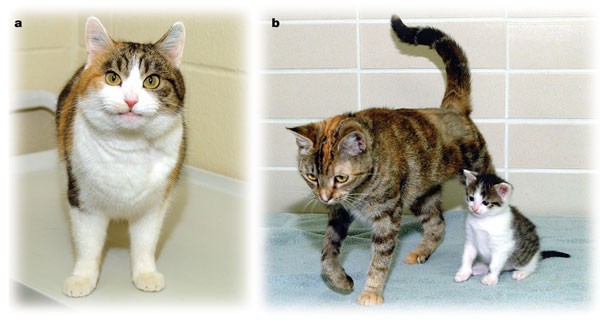A cat cloned by nuclear transplantation
Nature 415, 859 (2002)
This kitten's coat-coloration pattern is not a carbon copy of its genome donor's.
Abstract
Sheep, mice, cattle, goats and pigs have all been cloned by transfer of a donor cell nucleus into an enucleated ovum1,2,3,4,5, and now we add the successful cloning of a cat (Felis domesticus) to this list. However, this cloning technology may not be readily extendable to other mammalian species if our understanding of their reproductive processes is limited or if there are species-specific obstacles.
Main
As a first attempt, we isolated adult fibroblast cells from oral mucosa obtained from an adult male cat, passaged them three to seven times for expansion in culture, and then froze and stored them in liquid nitrogen. For nuclear transfer, we thawed these cells and fused them with cat ova that had matured in vitro and which had had their metaphase chromosomes removed by micromanipulation (see supplementary information). We then transferred cloned embryos into synchronized recipient queens for development.
We carried out 188 such nuclear-transfer procedures, which resulted in 82 cloned embryos that were transferred into seven recipient females. One queen became pregnant with a single conceptus, which ceased to develop and was surgically removed after about 44 days of gestation. Subsequent DNA analysis confirmed that the fetus was derived from a cloned embryo.
Our second attempt involved using nuclei from another cell type for transfer, which we obtained by primary culture of cumulus cells collected from an adult female cat. In a single experiment, three cloned embryos derived from cumulus cells and two cloned embryos derived from fibroblast cells were transferred into a recipient queen. Pregnancy was confirmed by ultrasonography after 22 days of gestation and a kitten was delivered by caesarian section on 22 December 2001, 66 days after the embryo was transferred. The kitten was vigorous at birth and appears to be completely normal.
The kitten's coat colour suggested that it was derived from a cumulus cell from the female donor (Fig. 1); we therefore analysed DNA of the cumulus cells used for nuclear transfer, as well as from leukocytes in blood samples from the donor cat and surrogate mother, and from cheek cells collected in an oral swab from the kitten. We also analysed control feline samples for comparison with a random-bred cat genetic database. Analysis of seven unlinked, highly polymorphic, feline-specific microsatellite loci confirmed that the kitten is a clone (Table 1).
a, Adult female cat that supplied cumulus cells for nuclear transplantation. The cells were cultured in DMEM/F12 medium for 5 days at 37 °C until confluent; micromanipulation was used to enucleate ova obtained after routine ovariohysterectomy and to transfer the donor's cumulus cells into the perivitelline space. Enucleated ova and cumulus cells were fused by electrofusion; a second electropulse was applied to activate the oocytes. b, The surrogate mother, a synchronized recipient of three cloned embryos, produced one cloned kitten, which was delivered by caesarian section 66 days after embryonic transfer. For further details, see supplementary information.
As with other genetically identical animals with multicoloured coats, the cloned kitten's colour patterning is not exactly the same as that of the nuclear donor — this is because the pattern of pigmentation in multicoloured animals is the result not only of genetic factors but also of developmental factors that are not controlled by genotype.
At this point, we can only roughly evaluate the efficiency of cloning cats by nuclear transfer: 87 cloned embryos were transferred into eight recipients, resulting in one failed pregnancy and one live clone. This is comparable to the success rates obtained for other cloned species. On the other hand, the cloned kitten was born after the transfer of only three embryos derived from cumulus cells. It remains to be investigated whether this cloning efficiency is reproducible in cats.

No comments:
Post a Comment